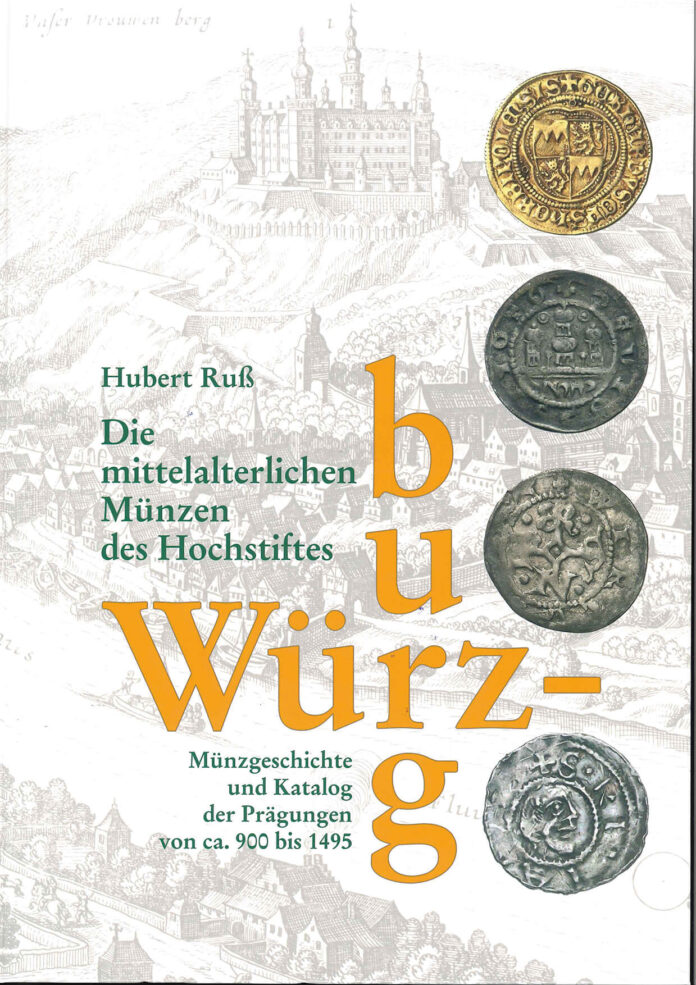
Books reflect the experiences of the people who wrote them. Regarding this book, you notice from the very first page that the author, Hubert Ruß, was annoyed by far too many reference works throughout his life that require a lot of time to use due to their chaotic structure. His new standard reference about the medieval coins of the Prince-Bishopric of Würzburg is clearly structured, comprehensive and written with much love and knowledge.
Scholar and Coin Dealer
Hubert Ruß is both scholar and coin dealer, and his book shows that. The scholar is apparent in condensed information and sound research, the coin dealer appears in the practical attitude of the author while presenting the material. In a way, the author has thus succeeded in squaring the circle: he wrote a work that meets the highest scholarly standards, that is easy to use for coin dealers and that provides coin collectors with the reading material which makes coins so exciting for them.
The Diocese of Würzburg: From the Early Middle Ages to the 15th Century
Let’s start at the beginning: legend has it that Boniface himself established a diocese in the strategically located area of Würzburg in the middle of the 8th century. Würzburg is crossed by the Main, the river that flows via Frankfurt into the Rhine, thus connecting rich Bohemia and the medieval trade and craft centres in the Rhineland and the Flemish Region. Würzburg was a transport hub. And whoever controlled this hub was of highest political and economic importance to the empire. Thus, it’s no surprise that the German kings granted Würzburg a share of their privilege of minting coins quite early. The oldest Würzburg coin known to date was minted under Louis the Child (899-911)! And for many centuries, German kings and bishops exercised the right to mint coins at the same time.
A Type Catalogue With Many Features
In one chapter, Hubert Ruß deals with all these early medieval coins up to the time when the Würzburg bishops assumed the exclusive privilege of minting coins.
As of Erlung (1106-1121) to Rudolf II von Scherenberg (1466-1495), one chapter is dedicated to every single bishop. The structure is always the same: life, history of coinage, catalogue.
Hubert Ruß presents the biography of every single bishop and his historical context – and not in Wikipedia style! He describes the bishops’ lives in short essays, in which financial policies play a decisive role provided that appropriate sources exist.
The essays are followed by the coinage history of the respective bishop. In this part, the author gives insight into the context of the bishops’ coins regarding economic and monetary history, both at local and supra-regional level. From these introductions to the catalogue you can see just how much work went into the book.
Obviously, the catalogue itself is impressive, too: it’s a type catalogue with a photo and a detailed description of every type. All lettering varieties are listed – without additional photos – not because it would have been difficult to find the photos but because like this it’s easier for users to identify a coin. An extensive list of where the coin type can be found – in coin cabinets, literature, hoards and auction catalogues – shows how common or rare a particular piece is.
Focusing on What Is Most Important
The book, beautifully designed and well-structured by prograph, impresses by the absence of anything superfluous. The greeting of the president of the district council was quietly squeezed to a left page. And the author even makes use of the preface to briefly summarise the research history.
And yet, the book contains everything you might wish for: an overview of coin staff and mints, several indexes of hoards arranged in different ways – alphabetically, chronologically and geographically – information on weights, sources, literature and illustrations…
Every coin dealer will be especially grateful to Hubert Ruß for his concordances and the monogram concordance, which will save you an infinite amount of time in the everyday life of coin identification!
Last but not least, one has to mention that Hubert Ruß added a register to his book that is not – as it is usual nowadays due to lack of time – limited to names and places but also contains subjects, motifs etc.
I like books that show that they weren’t written to flatter the vanity of an author, but because the numismatic world needs them and should use them. This is a book to use. Even for those who previously thought that medieval coins are difficult to identify
You can order the book from Künker for 95 euros.
And to learn more about the author, read the Who’s Who of Hubert Ruß.


